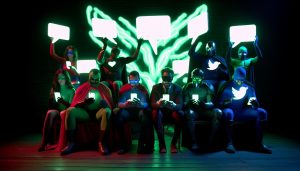If you’ve ever felt the sting of a mean comment online, you’re not alone. Even celebrities like Andrew Garfield don’t escape the sharp tongues of the internet, especially during #MeanTweets Week on Jimmy Kimmel Live. Garfield’s humorous reactions to these jabs reveal not just his wit but also how humor can transform negativity into something relatable and entertaining. In this article, we dive into Andrew’s unforgettable moments of clap-backs, showcasing the power of laughter in the face of online criticism and what it says about our shared experiences in today’s digital landscape. Join us as we explore how these viral moments resonate with fans and reflect the quirky side of social media culture!
Andrew Garfield’s Twitter Mean Tweets: A Breakdown
Andrew Garfield has proven that he can turn a mean tweet into comedic gold, showcasing his playful spirit every time he faces online criticism. In the iconic Mean Tweets segment on “Jimmy Kimmel Live,” he embraced the fun of reading those less-than-flattering remarks about him. From barbed comments questioning his acting abilities to light-hearted jabs at his fashion choices, Andrew’s reactions are what make these moments memorable and worth breaking down. This section highlights select tweets and Garfield’s clever retorts that not only serve as a defense but also as an opportunity to connect with fans through humor.
By engaging with the negativity rather than ignoring it, Andrew embodies the perfect blend of self-awareness and charm. This approach demonstrates an essential skill for navigating today’s internet culture-finding humor in adversity. His unique responses often elicit laughter not just from the audience but also from those who sent the original tweets, turning potential conflicts into collaborative comedy.
Moreover, Andrew’s responses reflect broader themes in online discourse. They serve as a reminder that celebrity status doesn’t shield one from criticism; rather, it offers a platform to demonstrate resilience and wit. By decoding the underlying humor in these exchanges, Garfield provides a masterclass in handling online backlash-turning hostile comments into engaging content that resonates with a wider audience and reinforces his appeal.
The effortless way he shifts from potential embarrassment to viral humor allows fans to see the lighter side of public scrutiny. This interaction cultivates a more relatable persona for Garfield, proving that laughter can be a powerful tool in diffusing negativity. Ultimately, Andrew Garfield’s take on mean tweets reminds viewers to embrace their quirks and come back with a smile, leaving a lasting impression across social media platforms.
The Humor Behind Andrew’s Responses
The world of Twitter is teeming with sharp humor and biting commentary, but few have mastered the art of hilarity and self-deprecation quite like Andrew Garfield. When faced with the sometimes brutal arena of mean tweets, Garfield turns potential slights into uproarious moments, showcasing that laughter can indeed be the best medicine. His responses don’t just sting back; they serve up a delectable blend of charm and wit that resonates with audiences. For those navigating the tricky waters of online commentary, Andrew’s reactions provide an engaging masterclass in humor and humility.
During his appearances on the “Mean Tweets” segment of *Jimmy Kimmel Live*, Garfield takes the heat from the digital realm and transforms it into a comedic performance. Imagine someone tweeting, “Andrew Garfield is like the vanilla ice cream of actors-completely forgettable.” Instead of letting this drag him down, he might retort with a cheeky grin, “Well, that’s a sweet flavor-everyone loves vanilla!” This clever turn flips the script, not only diffusing negativity but also engaging viewers in a way that feels inclusive rather than defensive.
His playful, self-aware responses do more than entertain; they draw viewers into a dialogue about how to handle criticism online. Many would benefit from embracing such a light-hearted approach. For instance, if you’re facing mean comments, instead of hurting your feelings, think of how you can craft a funny comeback that showcases your resilience. Here are a few tips inspired by Garfield:
- Find the funny: Look for the humor in the critique. Does it reflect their perspective more than reality?
- Keep it light: Counter with a joke or playful comment that shows you don’t take it too seriously.
- Engage your audience: Share your response; it’s a great way to connect with your followers and show them your personality.
- Be relatable: Reflect on how you, too, have faced criticism and how humor can bridge those tough moments.
Garfield’s infectious energy captures the essence of how to turn a potentially negative experience into a triumphant moment of levity. His adeptness at using humor to address online criticism not only entertains but also educates his audience, suggesting that perhaps we all can take a page from his book. The next time you come face-to-face with a mean tweet or mean comment, remember the spirit of Garfield’s clapbacks-laughter is always a punchline away.
Iconic Moments: Best Mean Tweets Compilation
In the ever-evolving landscape of internet culture, mean tweets have carved a niche that captures the humor and audacity of social media. Andrew Garfield, the beloved actor known for his portrayal of Spider-Man, has become a standout figure in the “Mean Tweets” segment on Jimmy Kimmel Live, where he doesn’t just weather the storm of insults but turns them into pure comedic gold. One of the most iconic moments came when a user quipped, “Andrew Garfield is the reason I couldn’t finish the Amazing Spider-Man movie.” Instead of sulking, Garfield shot back with a playful smile, asking if they wanted to “know what happens next,” effortlessly shifting the tone from criticism to a light-hearted conversation.
Even the more stinging remarks can’t dampen his spirits. A particularly notable tweet described him as “looking like someone tried to make an actor in a lab but ran out of ideas halfway through.” Garfield’s quick retort, suggesting he was a “work in progress” with just a hint of cheekiness, showcases his ability to embrace self-deprecation while engaging the audience. It’s moments like these that not only amuse viewers but also highlight the art of turning online negativity into a platform for connection and laughter.
For fans eager to see more of these iconic exchanges, the “Mean Tweets” compilations are a must-watch. They provide a glimpse into not just Garfield’s clever wit but also the wider cultural phenomenon where celebrities confront internet trolls with humor. Each clapback reinforces the notion that a little laughter can go a long way, and viewers resonate with Garfield’s ability to disarm critiques with charm.
In navigating your own online interactions, taking a cue from Garfield’s approach could be invaluable. The next time you find yourself targeted by unkind comments, take a moment to channel your inner Spider-Man and respond with a quip. After all, embracing humor not only makes the interaction more enjoyable but also transforms potential negativity into a memorable exchange that can resonate with your audience. Remember, like Garfield, you too can turn the tables on mean tweets, crafting responses that are as witty as they are uplifting.
The Cultural Impact of “Mean Tweets” Format
In a digital world where social media commentary often walks the line between hilarious and harsh, the “Mean Tweets” format has emerged as a standout cultural phenomenon that allows celebrities to confront their detractors with wit and humor. Through the clever juxtaposition of biting remarks and playful responses, shows like *Jimmy Kimmel Live* have turned what could be an uncomfortable moment into a source of entertainment that resonates with audiences across generations. This unique approach not only humanizes celebrities like Andrew Garfield, but it also offers a refreshing take on how we can handle negativity online.
This format succeeds because it encapsulates a universal truth: laughter truly is the best medicine. When Garfield quipped back at tweets calling him a “failed lab experiment” with a cheeky acknowledgment of being a “work in progress,” he didn’t just make viewers chuckle; he struck a chord with anyone who’s ever felt the sting of online criticism. These moments serve as powerful reminders that being in the spotlight doesn’t shield you from scrutiny, but choosing to face that scrutiny with humor can turn an attack into a showcase of personality, proving that engagement, rather than avoidance, is the key.
Celebrities tackling mean tweets also provide practical lessons for everyday users navigating the complexities of social media. Here are some tips inspired by this format that anyone can apply:
- Embrace Humor: Whenever you encounter criticism, consider responding light-heartedly to diffuse tension and connect with your audience.
- Self-Deprecation Works: Don’t be afraid to poke fun at yourself; it shows authenticity and relatability.
- Stay Engaged: Engage with your critics instead of ignoring them. A witty response can turn a negative into a memorable conversation.
- Know Your Audience: Tailor your responses to fit the mood and sensibilities of your followers to maximize impact and relatability.
As the “Mean Tweets” segment continues to evolve, it showcases a growing acceptance of humor as a coping mechanism in the often harsh reality of online interactions. For Garfield and others, it’s not just about making light of insults; it’s about transforming potential negativity into a platform for connection, inspiring countless fans to embrace their own uniqueness while gracefully navigating the world of social media trolls.
How Andrew Garfield Handles Online Criticism
Andrew Garfield’s approach to online criticism is a masterclass in humor and resilience, proving that even a “failed lab experiment” can kick back with a grin. He understands that social media can be a double-edged sword, filled with both praise and vitriol. Instead of taking offense, Garfield embraces the barbs directed at him, using them as material for laughter and connection. His ability to laugh at himself not only disarms critics but also resonates deeply with fans who appreciate his authenticity.
Garfield’s viral clapbacks remind us of the art of self-deprecation. For instance, when confronted with a particularly biting tweet, his response often ranges from witty to playful, transforming the negativity into a lighthearted moment. This deft handling of criticism suggests a fundamental truth about online interactions: engaging back with humor can diffuse hostility and build bridges instead of walls. Furthermore, his behavior offers practical takeaways for anyone facing online trolls-embracing a cheeky comeback can not only protect your mental space but also encourage others to adopt a lighter attitude toward their own encounters with negativity.
Of course, it’s not just about quick wit; it’s about cultivating a community that values humor. When Garfield participates in segments like Mean Tweets, he’s not just addressing personal jabs; he’s bridging a gap between celebrities and their audience. By showcasing his lighter side, he encourages fans to celebrate imperfections and shortcomings rather than fear them. This dynamic plays a vital role in fostering a more supportive online environment, where laughter reigns supreme over scorn.
In essence, Andrew Garfield’s strategy for tackling criticism serves as a lesson for us all. It’s not merely about how you respond to the tweet that stings but how you choose to spin it into something relatable and funny. For anyone looking to navigate the often treacherous waters of social media criticism, Garfield’s playful spirit and willingness to engage provide a refreshing blueprint for turning negativity into a source of shared laughter and understanding.
Analyzing the Virality of His Responses
Andrew Garfield’s responses to mean tweets have quickly become viral sensations, illustrating not just his quick wit but also the power of humor in transforming negativity into entertainment. When celebrities like Garfield engage with online criticism, they often activate a unique blend of social media dynamics that amplifies their reach and relatability. In Garfield’s case, his charming delivery and self-deprecating humor make his reactions highly shareable, sparking discussions and inspiring fans to share their own experiences of online trolling.
The viral nature of his clapbacks can be attributed to several factors. First, relatability plays a significant role; many fans appreciate that he doesn’t just brush off the jibes but acknowledges them with laughter. This approach encourages others to join the conversation, transforming a negative comment into a moment of shared humor. People love to see stars like Garfield humanize themselves-it reminds the public that everyone faces criticism, and the best response can often be a lighthearted one.
Another layer to the virality is the timing and format of his responses. In platforms like Twitter, punchy, concise reactions resonate more effectively, and Garfield’s ability to deliver clever comebacks within these constraints heightens his appeal. For example, during segments like Mean Tweets, not only does his comedic timing shine, but it also capitalizes on a popular format that already has a built-in audience, making it easier for his responses to spread like wildfire. The familiarity of the segment invites views, likes, and shares, creating a perfect storm for virality.
Moreover, Garfield’s mastery of self-irony elevates his content. His willingness to poke fun at himself-whether through expressing exaggerated disappointment or playful sarcasm-encourages fans to engage with his content, as they feel they’re part of an inside joke rather than passive observers. This not only improves his visibility on social media but enriches his relationship with fans, who feel included in the banter.
To harness this spirit, anyone navigating the choppy waters of online criticism can take inspiration from Garfield’s savvy handling of mean tweets. Here are a few tips to boost your own engagement:
- Respond with Humor: Use lightheartedness to defuse negativity; a clever comeback can turn the tide.
- Be Relatable: Share your own experiences with criticism; it helps build empathy and connection.
- Utilize Popular Formats: Engage with trending social media formats to maximize visibility.
- Stay Authentic: Authenticity draws people in-use your real voice and perspective.
By studying how Garfield turns mean tweets into moments of comedy, we can all learn valuable lessons about resilience and the potential for laughter when facing the harshness of the digital world.
Behind the Scenes: Creating the Tweets Segment
Crafting the “Mean Tweets” segment is an art form that blends creativity, timing, and celebrity charm, making it a beloved staple of internet culture. Behind the scenes, a team works meticulously to curate a list of humorous yet cutting comments from social media, ensuring they resonate with the celebrity’s persona while also eliciting genuine laughter. For Andrew Garfield, whose wit and relatable demeanor shine through, the process often involves selecting tweets that balance both sassy punches and playful mockery, reflective of his public image as the quirky yet endearing Spider-Man.
One crucial step in creating this segment includes the selection of tweets. Producers comb through social media platforms, searching for comments that showcase the perfect blend of humor and roast-worthy material. For Garfield, this means tweets that might poke fun at his past roles or his appearances, allowing him to cleverly engage with the narrative without feeling overly defensive. This selection process not only influences the comedic flow but also plays a significant role in constructing Garfield’s on-screen personality, portraying him as someone who can laugh at himself-a trait fans adore.
Once the tweets are chosen, the celebrity enters a rehearsal phase. Garfield, equipped with his natural humor, reviews the tweets, developing spontaneous responses and practicing his delivery. This ensures that when the cameras roll, his reactions come off as quick, authentic, and engaging. Keeping the tone light and playful, he infuses his responses with a dose of self-deprecation, elevating the humor in a way that encourages viewers to join in on the laughter. The goal is to create a shared experience where viewers feel connected through the shared humor of online trolling, transforming mean-spirited comments into a celebration of celebrity relatability.
In addition to the comedic elements, there’s a focus on production value. The segment is shot in a way that amplifies Garfield’s expressions, ensuring that every eye-roll or raised eyebrow enhances the humor. Editing plays a crucial role too, as cuts between the tweet and Garfield’s reaction are timed to heighten comedic impact. This meticulous crafting ultimately makes moments like Garfield’s responses to mean tweets not just a series of jokes but a memorable experience that resonates with audiences, illustrating how humor can deter negativity and allow personality to shine brightly on social media platforms.
In summary, creating the “Mean Tweets” segment is an intricate blend of tweet curation, rehearsal, and production finesse, focusing on delivering humor that connects with viewers. This careful art of engagement allows celebrities like Andrew Garfield not only to push through online negativity but also to enhance their relatability and foster a deeper connection with fans. The result? Viral content that not only entertains but reshapes the narrative around online interactions.
Fan Reactions: What Twitter Users Are Saying
When Andrew Garfield brings his charmingly witty takes to the “Mean Tweets” segment, Twitter users can’t help but respond with a mix of admiration, humor, and inspiration. The reactions to his clever comebacks often flood timelines, showcasing just how much fans appreciate a celebrity who can laugh at himself. He doesn’t just deliver zingers; he turns potential negativity into relatable, entertaining moments that resonate widely, making him a beacon of positivity in the often harsh landscape of social media.
Fans celebrate Garfield’s ability to transform snarky comments into comedic gold. Tweets often include phrases like “Andrew Garfield is officially my spirit animal” or “I aspire to roast like Andrew Garfield,” emphasizing not just his humor but also the aspirational quality his responses inspire. Many users remark on how his self-deprecating style elevates the entire concept of “Mean Tweets,” turning potential jabs into a shared experience of laughter rather than a personal attack. It’s a refreshing take that encourages others to adopt a similar approach when facing criticism.
For many, Garfield’s replies serve as a how-to lesson on dealing with online negativity. A typical comment might read: “Andrew Garfield out here proving that laughter really is the best medicine!” This indicates how followers are adopting his attitude of resilience, using humor as a tool to dispel negative vibes. This movement is emblematic of a broader trend where social media users are leaning into humor to counteract trolling, fostering a culture that prioritizes laugh over lash.
The sheer virality of Garfield’s segments fuels discussions and drives engagement that often spills over into memes and shared content on platforms like Instagram and TikTok. Users remix his best moments, creating short clips that capture his reactions, amplifying the reach of his humor even more. The participatory aspect of social media ensures that while Garfield reacts to mean tweets, fans join the fun, crafting their own responses or referencing his jokes, proving that humor is indeed contagious.
As more users take to Twitter to share their thoughts and reactions, it’s clear that Andrew Garfield’s ability to turn mean tweets into moments of joy and connection has not only made him a fan favorite but has also contributed positively to the dialogue around celebrity interactions online. Engaging with his content encourages followers to approach online discourse with a light heart and an understanding that humor, when wielded well, can transform the narrative around criticism.
Comparing Andrew’s Tweets to Other Celebrities
When it comes to the “Mean Tweets” segment, Andrew Garfield stands out not just for his charm but for his unique ability to blend humor with humility in a way that many other celebrities may struggle to match. Unlike some stars who might respond to criticism with defensiveness or sarcasm, Garfield approaches the jibes with a lightheartedness that resonates well with his audience, proving that laughter can be the best defense against negativity.
H3: The Approach of Other Celebrities
- Jon Stewart: Known for his incisive wit, Stewart offers sharp, pointed responses that are often laced with political commentary. While entertaining, his tweets can come across as more combative, while Garfield’s replies seem to promote connection rather than division.
- Ryan Reynolds: With a knack for self-deprecation similar to Garfield’s, Reynolds often mixes his mean tweet responses with a bit of playful self-mockery. Both stars excel in combining humor with humility, but Reynolds tends to skew towards more outrageous, scene-stealing comebacks that might overshadow Garfield’s grounded, relatable approach.
- Ariana Grande: Known for her sassy clapbacks, Grande often uses humor to respond to mean comments, but her style can be more tongue-in-cheek and less self-referential than Garfield’s. Grande’s approach often emphasizes glam and confidence, contrasting with Garfield’s more introspective and accessible hilarity.
H3: Why Garfield’s Style Works
Garfield’s responses are often relatable, demonstrating a vulnerability that resonates deeply with fans. While others may rely on wit alone, his knack for making the audience feel involved-like they’re part of an inside joke-allows his humor to transcend mere entertainment. This difference in delivery catapults him into a league where he’s not just responding to mean tweets; he’s inviting everyone to laugh along, turning potential slights into a shared comedic moment.
Furthermore, Garfield’s ability to balance humor with emotional intelligence is where he truly shines. He doesn’t just give a witty answer; he often nudges the audience to consider the absurdity of social media culture. His replies encourage a broader conversation about online interactions-making it clear that while mean tweets are a part of celebrity life, they don’t have to break a person down. Instead, they can uplift the community, and cultivating that relationship with humor transcends simple celebrity banter.
So, while celebrities like Reynolds and Grande certainly engage in their fair share of humor, Garfield’s blend of playfulness with personal relatability sets him apart, creating an authentic connection with fans that many aspire to emulate. In a world often filled with cyberbullying, Garfield exemplifies how humor can heal, inspire, and unite in the face of critique.
Top Fan Theories About Spider-Man and Garfield
When it comes to Spider-Man, Andrew Garfield has sparked a flurry of fan theories that resonate strongly with internet culture and social media banter. These theories not only explore his character interpretations but also draw connections between his portrayal and broader themes in the Spider-Man universe, often punctuated by the humorous take that rooted in the “Mean Tweets” segments. Fans love to dissect his nuanced performances and how they can be both a nod to comic lore and a playful jab at the superhero genre.
One prevalent theory among fans suggests that Garfield’s Spider-Man is a representation of the “sensitive hero.” Unlike previous portrayals, his version emphasizes emotional depth, often poking fun at how a superhero balances powers with personal insecurities. This angle is ripe for humor, especially given Garfield’s lighthearted responses to criticism. For example, fans might tweet about how his Spider-Man would likely cry after an awkward date, leading to hilarious imagined scenes that bring him down to earth. This relatability is not only humorous but makes Garfield’s Tweets resonate more deeply with his audience, who appreciate how he weaves personal experiences into the Spider-Man narrative.
Another playful theory revolves around the idea that Garfield’s Spider-Man exists in a multiverse of comedic timing, where every witty comeback aligns perfectly with a memorable scene from the movies. Fans love to create memes that tie his best “Mean Tweets” responses to iconic moments from the films. Imagine a meme where Garfield responds with a quippy one-liner from his Twitter to match the emotional weight of a serious scene! This blending of realities not only highlights the absurdity of being both a superhero and a meme-worthy celebrity but also showcases how humor permeates even the darkest moments in a superhero’s journey.
Garfield himself seems to embrace this mix of playful banter and deeper cinematic themes. His “Mean Tweets” often highlight the absurdities of both the online discourse and the comic book world, creating a space where fans can feel included in the joke. This back-and-forth lends itself to engaging Twitter threads and discussions, encouraging fans to share their “what if” scenarios alongside their favorite memes. Consequently, these interactions shape a unique community where humor and pop culture collide, reflecting the vibrant nature of social media today.
Ultimately, the theories surrounding Andrew Garfield’s Spider-Man and his humorous Tweets represent the beautiful intersection of fandom and internet culture. They allow fans to engage creatively while celebrating the quirks of superhero narratives, making for a wildly entertaining experience that transcends traditional fandom barriers. Whether it’s through mean-spirited Tweets or heartfelt memes, Garfield’s impact continues to resonate, proving that humor indeed can be the best web-slinger in bridging relationships among fans.
Lessons in Humor: How to Respond to Hate
Navigating the tricky waters of online criticism can feel like dodging verbal web-slingers, but there’s an art to mastering hilarious comebacks that Andrew Garfield showcases brilliantly through his “Mean Tweets.” Garfield demonstrates that you can defuse negativity by turning it into humor, keeping the audience on your side while maintaining your dignity. His playful yet poignant replies show that laughter is often the best medicine against the barrage of mean-spirited comments.
To effectively respond to hate, consider these tips inspired by Garfield’s approach:
- Embrace the Humor: Instead of letting negativity get under your skin, use wit to transform it. A clever retort can disarm critics, and sharing it publicly turns a jab into a source of joy for your fans.
- Stay Authentic: Garfield’s responses feel genuine because they reflect his personality. Be true to yourself in your reactions; it’s more relatable and engaging.
- Know Your Audience: Not every comment is worth responding to. Choose wisely which criticisms you want to address, preferably those you can turn into lighthearted banter that resonates with your followers.
- Incorporate Pop Culture: Like Garfield, weave in references from movies, memes, or trending topics that your audience loves. This not only makes your response fun but also engages your followers in a shared culture.
Building a community around your humor is essential. Just as Garfield invites his fans to join in on the jokes, creating a dialogue around your responses can foster a sense of belonging. Encourage your followers to share their playful takes on criticism, turning negative interactions into collective laughs. This way, you not only lighten your load but also cultivate an engaged audience ready to support you against the haters.
In essence, mastering the art of the clap back is about blending humor, authenticity, and relatability. By doing so, you create a unique space online where negativity struggles to survive, overshadowed by laughter and camaraderie. Just take a page from Andrew Garfield’s playbook-after all, if a superhero can handle the heat with a laugh, so can you!
Crafting Your Own Clap Back: Social Media Tips
Navigating the wild world of social media isn’t just about crafting the perfect selfie or posting viral memes; sometimes, it’s about responding to the occasional harsh critique with grace and humor-just like Andrew Garfield brilliantly does during “Mean Tweets.” Crafting a memorable clap back can elevate your social media game while keeping your cool. Here are some tips on how to harness your inner superhero and respond to negativity with style.
First up, find your comedic voice. Andrew Garfield’s responses shine because they are clear reflections of his personality, blending humor with authenticity. Think about what makes you laugh and how you can incorporate that into your replies. Experiment with different tones-sarcastic, witty, or even absurd-to see what resonates best with your audience. Being genuine will not only make your comeback feel more natural, but it will also connect better with your followers, making the humor feel less like a defense mechanism and more like a shared joke.
- Use Relevant References: Just like Garfield weaves in pop culture, you can grab attention with clever references to trending topics, movies, or memes that your audience might relate to. This makes your clap back not just a response, but a conversation starter.
- Choose Your Battles Wisely: Not every negative comment deserves a reply. Focus on ones that may maximize engagement or those that allow you to showcase your humor, turning potential hostility into a memorable exchange.
- Engage Your Community: Encourage followers to join in on the fun. A great way to do this is by creating challenges where you invite fans to respond humorously to their own experiences with online criticism, creating a supportive community where humor triumphs over negativity.
Finally, remember to show resilience in the face of criticism. Garfield’s approach teaches us that laughter can be an effective shield. Use humor to turn a jab into a laugh and foster a positive dialogue around your brand or personality. A clever clap back not only showcases your wit but also reinforces your credibility and ability to handle the complexities of social media with flair.
By weaving in humor, relatability, and relevant expressions from internet culture, your clap back can become more than just a witty response; it can turn a moment of negativity into an opportunity for connection, engagement, and even laughter. So channel your inner Spider-Man-after all, with great power (and a good sense of humor) comes great responsibility!
FAQ
Q: What are some of Andrew Garfield’s most memorable clapbacks to mean tweets?
A: Andrew Garfield’s memorable clapbacks include witty responses that showcase his humor while addressing online criticism. For example, he often plays along with the absurdity of the tweets, turning negative comments into light-hearted banter. His ability to blend humor with charm makes these moments iconic. For a deeper dive, check out the “Iconic Moments” section in the article.
Q: Why is Andrew Garfield’s approach to mean tweets considered unique?
A: Andrew Garfield’s approach is unique because he embraces the negativity with humor rather than defensiveness. He uses his platform to diffuse tension and promote positivity, making audiences laugh instead of feeling antagonistic. This technique contrasts with typical celebrity responses and resonates well with fans.
Q: How can fans effectively engage with Andrew Garfield on social media regarding mean tweets?
A: Fans can engage by sharing supportive comments or playful jabs that echo Garfield’s humor. Using relevant hashtags and tagging him can increase visibility. Participate in trending conversations and maintain a light-hearted tone, as seen in his responses. For tips on crafting your own responses, see the “Crafting Your Own Clap Back” section.
Q: When did Andrew Garfield first respond to mean tweets, and what was the impact?
A: Andrew Garfield first gained attention for responding to mean tweets during a segment on social media. This practice garnered significant buzz, enhancing his public persona and helping normalize humor in addressing online negativity. The impact shifted how celebrities might approach online criticism.
Q: How does Garfield’s humor reflect broader internet culture?
A: Garfield’s humor reflects a growing trend of embracing memes and viral formats like “Mean Tweets.” His responses signify a cultural shift towards resilience and humor in the face of online vitriol, engaging younger audiences who appreciate authenticity and playfulness.
Q: What lessons can be learned from Andrew Garfield’s interactions with mean tweets?
A: Key lessons include the importance of maintaining a sense of humor and authenticity when facing criticism online. Garfield shows that responding with wit can transform negative energy into positive engagement, fostering community support rather than division.
Q: Where can I watch Andrew Garfield’s funniest reactions to mean tweets?
A: You can watch compilations of Andrew Garfield’s funniest reactions on platforms like YouTube, particularly in segments that showcase celebrity interactions with mean tweets. These clips highlight his charm and humor, delivering both entertainment and insight.
Q: How have fans reacted to Andrew Garfield’s mean tweet responses?
A: Fans often react positively, praising his humor and authenticity. Many appreciate his ability to take criticism in stride, which fosters a strong fan connection. His responses frequently go viral, reflecting a supportive online community that enjoys light-hearted ridicule while celebrating his persona.
Engage with the conversation and explore more about Andrew’s humorous takes on mean tweets in our detailed analyses!
In Conclusion
Thanks for watching “Andrew Garfield Mean Tweets: Spider-Man’s Hilarious Clap Back!” If you enjoyed these playful jabs and want to keep the laughter going, don’t forget to check out our breakdown of the funniest moments from other celebrity mean tweets-your next favorite video could be just a click away! And if you want more insider looks into viral Twitter trends and social media culture, subscribe to our newsletter for exclusive content.
Make sure to drop your thoughts in the comments below-what was your favorite tweet? Share this video with your fellow Spider-Man fans and keep the conversation alive! Remember, the fun doesn’t stop here; explore our channel for more entertaining content that dives deep into internet culture and gives you all the tips on navigating social media like a pro. See you next time!










